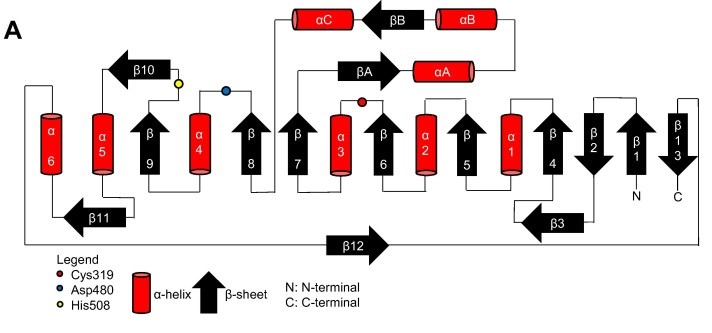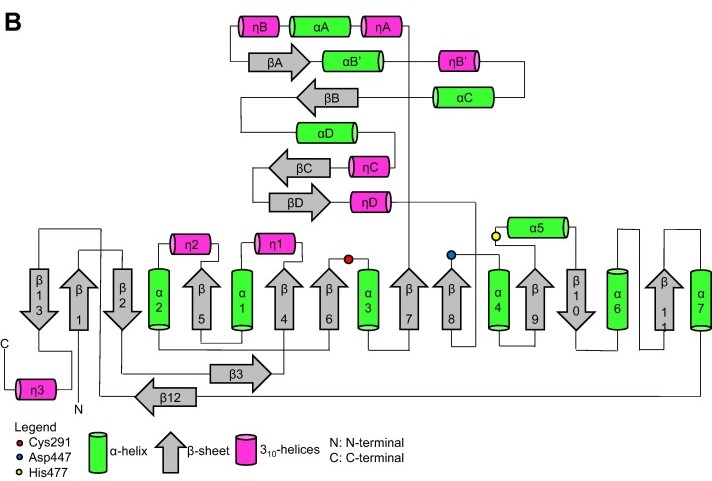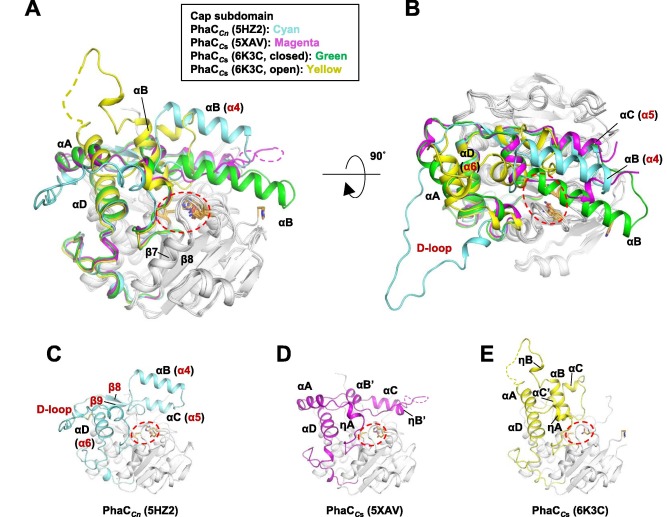User:Gustavo Sartorelli de Carvalho Rego/Sandbox 1
From Proteopedia
(Difference between revisions)
| Line 16: | Line 16: | ||
=== C-terminal domain === | === C-terminal domain === | ||
| - | Contrary to the flexible N-terminal domain, the <scene name='10/1050300/Phac_i_catalytic_c_domain/2'>C-terminal domain</scene> is relatively stable, making its crytalization process easier. Because of this, it was possible to obtain the C-terminal domain structure from PhaC<sub>cn</sub>-CAT and PhaC<sub>cs</sub>-CAT through X-ray cristallography, with resolution of 1.8 Å and 1.48 Å, respectively. The C-terminal domain has the <scene name='10/1050300/Phac_i_catalytic_site/2'>catalytic site, with the aminoacid triad (Cys-Asp-His)</scene>, the substrate entrance and the product egress tunnel. | + | Contrary to the flexible N-terminal domain, the <scene name='10/1050300/Phac_i_catalytic_c_domain/2'>C-terminal domain</scene> is relatively stable, making its crytalization process easier. Because of this, it was possible to obtain the C-terminal domain structure from PhaC<sub>cn</sub>-CAT and PhaC<sub>cs</sub>-CAT through X-ray cristallography, with resolution of 1.8 Å and 1.48 Å, respectively. The C-terminal domain has the <scene name='10/1050300/Phac_i_catalytic_site/2'>catalytic site, with the aminoacid triad (Cys-Asp-His)</scene>, the substrate entrance and the product egress tunnel.<ref name='Neoh' /> |
| - | The overall form of a phaC protein is that of a typical protein from the α/β-hydrolase-fold, with the C-terminal domain made of an <scene name='10/1050300/Phac_i_catalytic_hydrolase_sub/1'>α/β-hydrolase core subdomain</scene> and a <scene name='10/1050300/Phac_i_catalytic_cap_sub/1'>Cap subdomain</scene>, corresponding to the Thr347-Pro471 residues in PhaC<sub>cn</sub>, and Thr319-Pro438 residues in PhaC<sub>cs</sub>. It is in the α/β-hydrolase subdomain that the entrance tunnel, the catalytic site and the product egress tunnel are located. This region seems to be preserved in phaCs. | + | The overall form of a phaC protein is that of a typical protein from the α/β-hydrolase-fold, with the C-terminal domain made of an <scene name='10/1050300/Phac_i_catalytic_hydrolase_sub/1'>α/β-hydrolase core subdomain</scene> and a <scene name='10/1050300/Phac_i_catalytic_cap_sub/1'>Cap subdomain</scene>, corresponding to the Thr347-Pro471 residues in PhaC<sub>cn</sub>, and Thr319-Pro438 residues in PhaC<sub>cs</sub>. It is in the α/β-hydrolase subdomain that the entrance tunnel, the catalytic site and the product egress tunnel are located. This region seems to be preserved in phaCs.<ref name='Neoh' /> |
| - | Regarding the <scene name='10/1050300/Phac_i_catalytic_cap_sub/1'>Cap subdomain</scene>, the LID region is extremely dynamic and flexible, having an open or closed conformation based on structural changes. Because of this, the Cap subdomain, specially the LID region, is not as conserverd in the phaCs as the α/β-hydrolase subdomain. The Cap subdomain is located after the β7 sheet, and connects with the β8 sheet from the α/β-hydrolase core. In PhaC<sub>cn</sub>, the Cap subdomain is formed by three α-helixes (α4, α5 and α6) and two β-sheets (β8 and β9). Meanwhile, PhaC<sub>cs</sub> has six α-helixes (αA, αB, αC, αD, ηA and ηB'). | + | Regarding the <scene name='10/1050300/Phac_i_catalytic_cap_sub/1'>Cap subdomain</scene>, the LID region is extremely dynamic and flexible, having an open or closed conformation based on structural changes. Because of this, the Cap subdomain, specially the LID region, is not as conserverd in the phaCs as the α/β-hydrolase subdomain. The Cap subdomain is located after the β7 sheet, and connects with the β8 sheet from the α/β-hydrolase core. In PhaC<sub>cn</sub>, the Cap subdomain is formed by three α-helixes (α4, α5 and α6) and two β-sheets (β8 and β9). Meanwhile, PhaC<sub>cs</sub> has six α-helixes (αA, αB, αC, αD, ηA and ηB').<ref name='Neoh' /> |
The cristallography of PhaC<sub>cs</sub>-CAT bound to its substrate revealed the complex assymetric dimer structure of this enzyme. The phaC dimer form can be induced by the presence the substrate. Due to the dynamic and flexible properties, specially of the LID region, the Cap subdomain is paramount in the phaC dimer formation and regulation of substrate entry and product release, since it determines the protomer's movements, regulating the change between the closed form - homodimer- and the open form - heterodimer. <ref name='Neoh' /> | The cristallography of PhaC<sub>cs</sub>-CAT bound to its substrate revealed the complex assymetric dimer structure of this enzyme. The phaC dimer form can be induced by the presence the substrate. Due to the dynamic and flexible properties, specially of the LID region, the Cap subdomain is paramount in the phaC dimer formation and regulation of substrate entry and product release, since it determines the protomer's movements, regulating the change between the closed form - homodimer- and the open form - heterodimer. <ref name='Neoh' /> | ||
| Line 46: | Line 46: | ||
== Class 4 == | == Class 4 == | ||
| - | Just like class 3, <scene name='10/1050300/Phac_class_iv/1'>the class 4 is also composed by two enzymatic units, phaC (catalytic subunit)</scene> and <scene name='10/1050300/Phar_class_iv/1'>phaR</scene>, and has a smaller molecular mass than the other classes. The class 4 phaC also produce preferentially short chain PHAs, with 3 to 5 carbon monomers. | + | Just like class 3, <scene name='10/1050300/Phac_class_iv/1'>the class 4 is also composed by two enzymatic units, phaC (catalytic subunit)</scene> and <scene name='10/1050300/Phar_class_iv/1'>phaR</scene>, and has a smaller molecular mass than the other classes. The class 4 phaC also produce preferentially short chain PHAs, with 3 to 5 carbon monomers.<ref name='Neoh' /> |
== References == | == References == | ||
<references/> | <references/> | ||
Revision as of 14:53, 2 June 2024
Introduction
| |||||||||||



